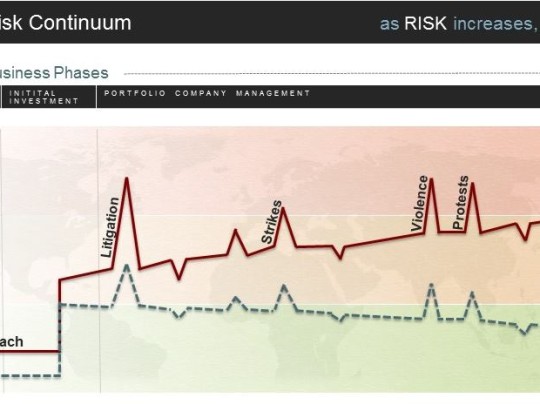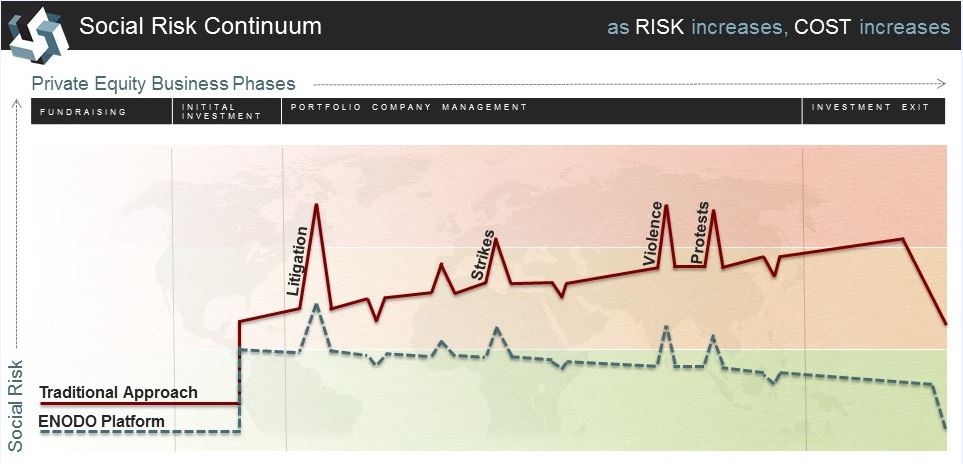 Accurately assessing risk is a critical factor within each phase of the private equity business model. From fundraising to the ultimate sell-side transaction, evaluating and mitigating risk is fundamental to the success and sustainability of a private equity business. Some private equity firms have not optimized their investments, particularly in frontier markets because of a gap that exists in their risk portfolio. Today’s complex environments require in-depth understanding of the threats that emanate from societies. Private equity firms’ reliance on standard operating procedures and traditional risk analysis does not (1) prepare them for the negative impacts of social risk, (2) safeguard investments from an extreme financial loss or reputational damage, or (3) optimize returns for Limited Partners.
Accurately assessing risk is a critical factor within each phase of the private equity business model. From fundraising to the ultimate sell-side transaction, evaluating and mitigating risk is fundamental to the success and sustainability of a private equity business. Some private equity firms have not optimized their investments, particularly in frontier markets because of a gap that exists in their risk portfolio. Today’s complex environments require in-depth understanding of the threats that emanate from societies. Private equity firms’ reliance on standard operating procedures and traditional risk analysis does not (1) prepare them for the negative impacts of social risk, (2) safeguard investments from an extreme financial loss or reputational damage, or (3) optimize returns for Limited Partners.
In mature U.S. and Western European markets, a significant portion of private equity capital has been deployed. This has driven up valuations and put pressure on average returns for the asset class. To achieve annualized returns of 25-30%, previously commonplace in the private equity sector, firms will need to extend their investment mandates into frontier and emerging markets. Investing in these markets, however, requires understanding risks not addressed by traditional diligence processes. Social risk manifests from individuals, communities, or activist groups in the form of litigation, protests, and violence. It is also the most commonly ignored or misunderstood risk and has the greatest impact on companies’ operations.
ENODO Global’s Social Alignment Cubed (SA³) operating platform was designed to help private sector clients identify, understand, and mitigate the impacts of social risk. Our social alignment framework and population-centric methodology pinpoint the underlying causes of instability that can negatively affect a company’s cash flow and reputation. ENODO’s specialized analysis enables private equity clients to:
• Avoid acquiring assets with lopsided risk / return profiles
• Identify and quantify social synergies that increase cash flow and promote the enterprise’s reputation
• Petition for higher leverage at a lower cost
• Mitigate impacts of social risk (protests, litigation, and violence)
• Reduce operating costs through strategic community engagement
• Lower insurance premiums
• Forecast political, economic and social instability to determine when to exit an investment
• Increase the number and size of bids when selling an asset
• Safeguard firm’s and limited partners’ reputations
• Create socially responsible investments
Initial Investment: Identify social synergies and lower debt costs
The primary challenge during the initial investment phase is to evaluate a target’s existing cash flow and growth prospects to generate a bid that enables financial success. ENODO augments this process in two ways. First, ENODO’s Initial Investigations enrich market screens by identifying the social risks currently affecting a sector or geographic area – these enhance traditional operational, geopolitical, technical, and country risk assessments (Social Risk for Multinationals). Second, ENODO’s Quick Look Reports reveal critical social risks in the acquisition target’s current operating environment and forecast potential threats. Private equity firms can utilize this information to quantify social synergies into their financial model’s projected cash flow to refine bids and avoid investing in assets with disproportionately high levels of social risk. Quick Look Reports also help private equity firms educate investment banking debt and equity committees on the local environment in order to petition for higher multiples of leverage at a lower interest rate.
Portfolio Company Management: Engage the community and protect cash flow
In the management phase, the challenge is for private equity teams assigned to the portfolio company to identify and create managerial and operational efficiencies. ENODO’s Outlook Reports enhance this process in three ways. First, Outlook Reports forecast social tensions, identify opportunities to establish or strengthen stakeholder relationships and deliver engagement strategies to mitigate potential threats. Second, Outlook Reports are used by the portfolio company to apprise insurance underwriters of its assets’ true risk level and allow management to re-negotiate lower premiums. Third, Situation Reports provide daily, weekly, or monthly updates that monitor on-the-ground activities and forecast potential events. Outlook and Situation Reports enable portfolio companies to proactively engage target groups and implement strategies to avoid the costs associated with social risk.
Investment Exit: Increase the multiple on unrealized gains
An important challenge for every sponsor is deciding when to exit an investment to maximize returns. This issue is compounded in frontier markets where there are a limited number of buyers. ENODO assists the sell-side process in three ways. First, ENODO’s adaptive methodology produces Situation Reports that forecast future stability or instability, which drive valuations. This enables private equity firms to strategically exit an investment at the most lucrative time. Second, including ENODO’s Quick Look and Situation Reports into the sell-side information memorandum or data room can assuage potential buyers’ discomfort of operating in an unfamiliar market. The more in-depth Outlook Report, shared later in the due diligence process, provides potential buyers a guide to engage the population and avoid the pitfalls of operating in a new environment. Third, the reports inform debt and equity committees about an asset’s true level of risk, providing information to increase leverage and lower interest rates for the ultimate buyer. The end result is an increase in the number of interested buyers who simultaneously see less risk in purchasing an asset in a new market.
Fundraising: Socially responsible in all markets
Fundraising is the most critical phase in the private equity business model, but is often overlooked by advisors. The major challenge of raising a private equity fund is proving that the firm’s business model and investment strategy is both differentiated from competitors and able to achieve future returns, while protecting limited partners from any reputational risk. ENODO can offer a distinct advantage in this regard. Endowments, family offices, pension funds, and other limited partners want the diversification and superior returns offered by the private equity asset class, but need to avoid reputational damage from investing in firms linked to global conflict, environmental disasters and labor exploitation. Furthermore, many limited partners use social impact criteria when evaluating investment in private equity funds. Today, over $6 trillion of such investments are considered socially responsible. By incorporating ENODO’s platform into their portfolio companies’ operations, private equity firms can demonstrate to investors that no matter what the target sector or geography, employees and local populations will not be adversely affected. Moreover, the platform creates Utility without Dependency™ so there is a lasting benefit to the community beyond the typical 3-7 year investment cycle.

ENODO’s Social Risk Continuum provides a visual representation of the various levels of social risk experienced throughout the phases of the private equity business model. In the fundraising and initial investment phases, social risk is negligible until an asset is purchased. Upon purchase, the private equity firm immediately assumes the social risk of the portfolio company. During the management phase, the private equity firm is continuously exposed to social risks that manifest in the form of litigation, strikes, violence, or protects. Without proactive mitigation strategies, social risk typically escalates and reaches its apex prior to the sale of the asset. In the investment exit phase, unrealized gains are exposed to the greatest levels of social risk since a single event can dramatically affect the sale price. After the sale, there is residual risk from the portfolio company failing to address social risk throughout project lifecycle. ENODO’s platform identifies and mitigates social risk during each phase of the private equity business model to limit the magnitude of events, systematically reduce costs and maximize profits.
Conclusion
ENODO’s operating platform offers private equity clients a socially responsible, proactive risk mitigation tool that can be applied to each phase of the private equity business model. SA³ enables clients to realize, monitor, and reduce the negative consequences of social risk on their investments. ENODO’s analytical products and consultative services deliver a competitive advantage by actively managing social risk, identifying operational efficiencies and aligning portfolio company and community objectives, which allows private equity firms to make more informed decisions. In today’s dynamic social environments where social tensions can quickly escalate to unrest or violence, ENODO’s capabilities are required to safeguard investments and profits.

